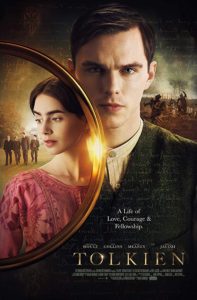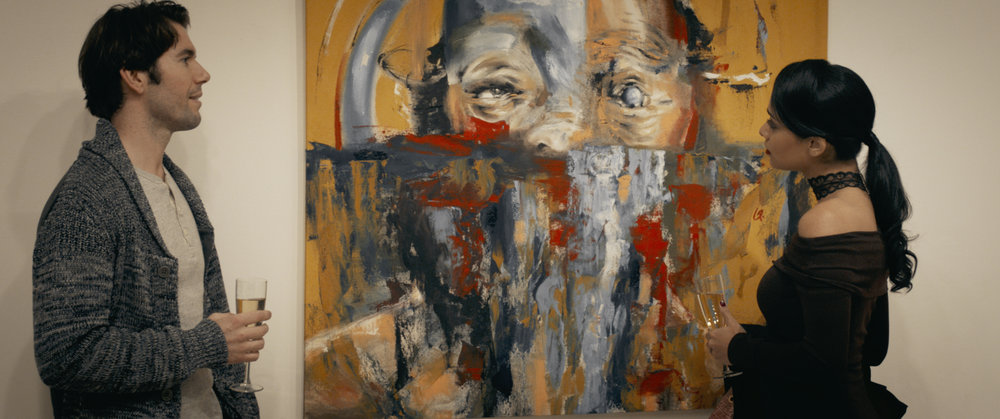 With a reputation built on works full of staggering narrative detail and deep mythological roots, J.R.R. Tolkien could perhaps be better described as a world builder than as an author. His mythological worlds have mythologies of their own, along with languages, heroes, villains, people, preferences, prejudices, and values. Dome Karukoski’s new biopic Tolkien takes a look at this world builder through his early life, and through the deaths that made The Hobbit and The Lord of the Rings what they are: stories about death set in worlds full of life.
With a reputation built on works full of staggering narrative detail and deep mythological roots, J.R.R. Tolkien could perhaps be better described as a world builder than as an author. His mythological worlds have mythologies of their own, along with languages, heroes, villains, people, preferences, prejudices, and values. Dome Karukoski’s new biopic Tolkien takes a look at this world builder through his early life, and through the deaths that made The Hobbit and The Lord of the Rings what they are: stories about death set in worlds full of life.
A common battle cry in the film for Tolkien’s “Tea Club, Barrovian Society”—a quartet of artists and would-be world-changers—was “Helheimr!” Pulled, the film’s Tolkien says, from Norse myth, “Helheimr” is a reminder that ignoble death awaits those who do not die honorably. Like the Etruscan Orcus before it, the Aztec Mictlān alongside it, and the Klingon Gre’thor in Star Trek long after it, Helheimr (or, perhaps more accurately, Hel—the name of both the place and the god who ruled over it) could be avoided by a warrior by dying in battle or performing some other final, honorable act.
But why use that morbid word as a battle cry for men who are neither Etruscan, Aztec, Klingon, or Norse?
A Knife in the Allegory
 J.R.R. Tolkien insisted in the foreword to his most famous work’s second printing, “as for any inner meaning or ‘message’, it has in the intention of the author none. It is neither allegorical nor topical.” And although he granted that “as the story grew it put down roots (into the past) and threw out unexpected branches,” he remained staunch that he not only didn’t insert allegory into the work, but he flat-out doesn’t even like the stuff.
J.R.R. Tolkien insisted in the foreword to his most famous work’s second printing, “as for any inner meaning or ‘message’, it has in the intention of the author none. It is neither allegorical nor topical.” And although he granted that “as the story grew it put down roots (into the past) and threw out unexpected branches,” he remained staunch that he not only didn’t insert allegory into the work, but he flat-out doesn’t even like the stuff.
Still, as the film Tolkien shows, even if not intentional, the emotional scars of his life affected his work. “By 1918 all but one of my close friends were dead,” he says later in the same foreword. And this close exposure to death seems to have affected his work in a way that he, himself, noticed, explaining it in a later commentary about the work written in a pair of letters from 1957 and 1958:
But I should say, if asked, the tale is not really about Power and Dominion: that only sets the wheels going; it is about Death and the desire for deathlessness. Which is hardly more than to say it is a tale written by a Man!
It is mainly concerned with Death, and Immortality; and the ‘escapes’: serial longevity, and hoarding memory.
In this I find a welcome loophole in Tolkien’s disdain for meaningful narrative, alongside another passage from the aforementioned foreword:
I much prefer history, true or feigned, with its varied applicability to the thought and experience of readers. I think that many confuse ‘applicability’ with ‘allegory’; but the one resides in the freedom of the reader, and the other in the purposed domination of the author.
So what is applicable, then, within the death Tolkien (the man) experienced and which Tolkien (the film) reveals; and within the Norse battle cry of the T.C.B.S.?
An Unexpected Applicability
 Humans are rather obsessed with death. It’s “hardly more than to say it is a tale written by a Man” to suggest that the tale is about death and an attempt to escape from it. We live in a world swallowed up by it, that nonetheless tries to hide it at every possible turn. But more than just the fact that we die, the mythology of “honorable death” from around the world and throughout history proves that how we die is just as important to our collective mental understanding of the world.
Humans are rather obsessed with death. It’s “hardly more than to say it is a tale written by a Man” to suggest that the tale is about death and an attempt to escape from it. We live in a world swallowed up by it, that nonetheless tries to hide it at every possible turn. But more than just the fact that we die, the mythology of “honorable death” from around the world and throughout history proves that how we die is just as important to our collective mental understanding of the world.
If we believe that man’s oft-repeated stories are echoes of God’s stories, then there must be an inherent reason for this story to be told so often. The Bible does, indeed, tell stories about the destinations of those who die honorably and those who die dishonorably:
And many of those who sleep in the dust of the earth shall awake, some to everlasting life, and some to shame and everlasting contempt.
—Daniel 12:2, ESV
The Bible does indeed make clear that no one can be awoken to everlasting life outside of Jesus’ grace, but it also reminds us that heavenly-mindedness is a powerful legacy in eternity:
But lay up for yourselves treasures in heaven, where neither moth nor rust destroys and where thieves do not break in and steal. For where your treasure is, there your heart will be also.
—Matthew 6:20-21, ESV
…the full weight of which shows that, for humans, dying well is at least as important as living well. And, in this light, that remembering our eventual demise makes us better people while we live.
So teach us to number our days that we may get a heart of wisdom.
—Psalm 90:12, ESV
So what does this have to do with the Norse battle cry of honorable death?
The Scouring of Helheimr
 As scholars and linguists and mythologists, this reality would not have been lost on the T.C.B.S. So “Helheimr!,” then, is a rallying cry reminding its users that a life must be lived for something; those who do not are cursed with an eternity of ignominy.
As scholars and linguists and mythologists, this reality would not have been lost on the T.C.B.S. So “Helheimr!,” then, is a rallying cry reminding its users that a life must be lived for something; those who do not are cursed with an eternity of ignominy.
This reality was driven deeply home for Tolkien when he returned from The Great War to find that two of his T.C.B.S. friends had not made it home. In pursuit of changing the world, they had gone off to war, died honorably in battle, and fulfilled the promise of “Helheimr” before Tolkien would ever have the chance to.
And with every honorable death in your fellowship, the battle cry grows in volume and power.
Together, the boys promised to change the world. Together (for that is the only way), they charged into battle. Together, they faced death with honor. And together, in small and large ways, they did change the world.
They died for a reason and avoided the shame of Helheimr.
But they didn’t just do it through battle.
Riddles in the Dark
Viking mythology doesn’t just bring us the concept and battle cry of Helheimr. Odin, the master deity of the Vikings, wasn’t merely a god of war and conquest. His honor wasn’t restricted to the field of battle. Yes, his name means “fury.”
But it also means “poetry.”
 Both the Vikings and the British, those who invented “Helheimr” and those who co-opted a Viking battle cry for themselves, come from a line of Warrior-Poets. In time of war, of course, honor meant fighting and perhaps dying in battle. But in peace? Then, it was time for the arts, and honor was found in creation.
Both the Vikings and the British, those who invented “Helheimr” and those who co-opted a Viking battle cry for themselves, come from a line of Warrior-Poets. In time of war, of course, honor meant fighting and perhaps dying in battle. But in peace? Then, it was time for the arts, and honor was found in creation.
Tolkien and the members of his Fellowship were driven to change the world; but before the war took from them their first loves, they were all artists. “Ronald” himself fell in love with a woman named Edith who deeply appreciated the arts. They found beauty and power there; they found honor there. The arts satisfied their “Helheimr” battle cry.
Why? Because God placed a lifegiving, life-affirming power within the arts; a power at least as great as that of war. Because God is a God of creation, and He placed that in our hearts. He placed a desire and a drive for it within us.
And because He can use it to change the world, as surely as he can use war.



1 comment